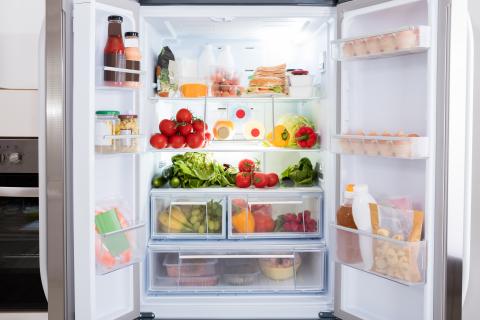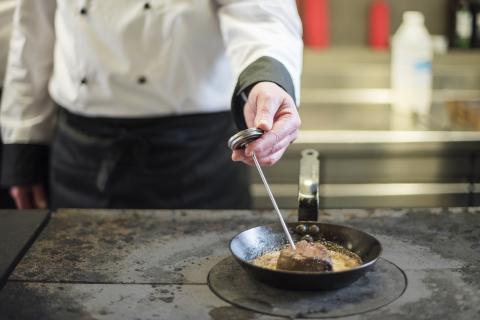Nutrition: Food Safety
Food poisoning (also called foodborne illness or foodborne disease) is by caused by consuming food contaminated with certain bacteria and viruses. Food safety refers to the best ways to handle, prepare, and store food to prevent illness.
Causes of food poisoning
Learn more about the harmful germs that cause food poisoning. Visit our food poisoning webpage.
Food safety rules
Follow these basic safety rules to help keep food safe and avoid illness.
Clean
Wash your hands frequently and clean surfaces touched by food. Germs can spread all over the kitchen, such as on cutting boards, knives, counter tops, sponges, and towels.
Separate
Keep raw foods—such as raw meat, poultry, and seafood—and their juices away from other foods. Germs spread from one food product to another.
Cook
Cook foods to the right temperature. Foods are properly cooked when they are heated for a long enough time and the internal temperature is high enough to kill harmful germs. Always use a thermometer to make sure meat, poultry, and fish reach a safe minimum cooking temperature.
Chill
Refrigerate food promptly. Germs can quickly multiply when food is left at room temperature. FDA recommends refrigerating food within than two hours. Refrigerate it within one hour if it’s 90°F or above (such as in a hot car). Set your fridge at 40° F and your freezer at 0° F.
Holiday food safety
Be safe when enjoying holiday goodies and other treats.
Tiger meat or cannibal sandwiches: For some Wisconsinites, it’s a tradition to eat raw ground beef dishes, known as tiger meat, steak tartare, or cannibal sandwiches. Eating this holiday fare is not without its risks.
Bacteria, such as Salmonella, E. coli O157:H7, Campylobacter, and Listeria can be found in raw and undercooked beef. In Wisconsin, there have been eight reported outbreaks linked to raw ground beef since 1986. An outbreak in December 1994 involved more than 150 people. This is a good reminder that ground beef should always be cooked to an internal temperature of 160° F.
No matter where you buy ground beef, you put your health at risk when eating this holiday dish.
Baked goods: As the U.S. Food and Drug Administration advises, you should not eat uncooked cookie dough that contains raw eggs. This includes homemade or store-bought dough and batter. Raw eggs may contain Salmonella, and flour has been linked to E. coli outbreaks. Proper and complete cooking kills these bacteria.
Eggnog: Traditional eggnog made with raw eggs can pose a risk. While cooking can kill bacteria, you can still become sick from eggnog that has been left at room temperature for several hours. The safest option is to buy pasteurized eggnog from the grocery store, and make sure to keep it in the refrigerator.
Apple cider and other juices: Apple cider and most juices sold at grocery stores are pasteurized or somehow treated to destroy harmful bacteria. However, you still may find unpasteurized or raw juice in grocery stores, health-food stores, cider mills, or farm markets. These juices will have the following warning on the label:
Warning: This product has not been pasteurized and therefore, may contain harmful bacteria that can cause serious illness in children, the elderly, and persons with weakened immune systems.
Not sure your cider or juice is pasteurized? Don’t drink it or boil it to kill any harmful bacteria.
Refrigerator safety
Cold temperatures slow the spread of harmful germs. The US Department of Agriculture (USDA) has these tips to make sure you’re storing foods the right way:
- Always refrigerate perishable food within two hours, or one hour if the food has been left in a temperature of 90°F or above (such as in a hot car).
- Check the settings with an appliance thermometer. Your refrigerator should be at 40°F or below. Your freezer should be at 0°F or below.
- Cook or freeze fresh poultry, fish, ground meats, and organ and variety meats (such as, heart, kidney, liver and tongue) within two days. Cook or freeze beef, veal, lamb, or pork within three to five days.
- Securely wrap perishable food, such as meat and poultry, to help maintain quality and prevent meat juices from getting onto other food.
- If freezing meat or poultry in its original package, wrap the package again with heavy-duty foil or freezer wrap.
Eating out
More than half of foodborne outbreaks are linked to restaurants. Follow these tips to protect yourself when you eat out:
- Send your food back if it’s not fully cooked. Certain foods, such as meat, seafood, poultry and eggs, need to be at a temperature high enough to kill harmful germs.
- Put your leftovers in the fridge within two hours of eating, or one hour if the temperature is above 90°F (such as in a hot car). Reheat your leftovers to 165°F.
- If you get food poisoning, and you think it’s linked to a restaurant, report your illness to your local health department.
Mail-order food
Follow these tips when you receive mail-order food, such as meat, poultry, and fish, as well as other perishables like cheese, fruit, and cheesecake.
- Make sure you know when your order is being delivered.
- Open the package as soon as it arrives.
- If the package has a “keep refrigerated” label, chill the food as soon as you get it.
More resources
- 4 Steps to Food Safety—FoodSafety.gov
- Food and Recreational Safety—Wisconsin Department of Agriculture, Trade and Consumer Protection
- Fight BAC!—Partnership for Food Safety Education
- FDA Food Information Line—1-888-SAFEFOOD (1-888-723-3366)
- USDA Meat and Poultry Hotline
- 1-800-535-4555
- TTY: 1-800-256-7072
- Email: mphotline.fsis@usda.gov





